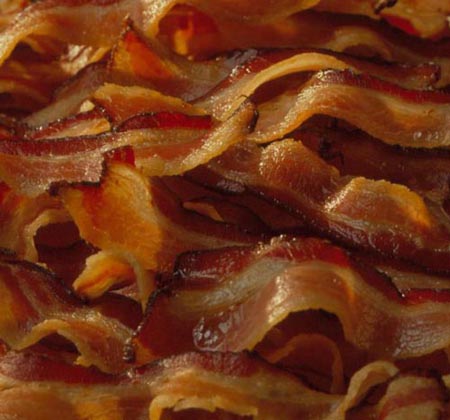 I have a theory that if you eat oatmeal and bacon during the same meal, such as breakfast, the oatmeal will absorb/remove the fat derived from the bacon, thus rendering it a cholesterol neutral meal. Scientists, any thoughts?
I have a theory that if you eat oatmeal and bacon during the same meal, such as breakfast, the oatmeal will absorb/remove the fat derived from the bacon, thus rendering it a cholesterol neutral meal. Scientists, any thoughts?
Discussion of Portland, Oregon restaurants and bars; successful recipes; and anything else loosely culinarily-related that interests me.

1 comment:
Debuking Colesterol Myth:
I
The main cholesterol producers are the liver
and the small intestine, in that order. Normally, they are able to
release cholesterol directly into the blood stream, where it is instantly
tied to blood proteins. These proteins, which are called lipoproteins,
are in charge of transporting the cholesterol to its numerous
destinations. There are three main types of lipoproteins in charge of
transporting cholesterol: Low Density Lipoprotein (LDL), Very Low
Density Lipoprotein (VLDL), and High Density Lipoprotein (HDL).
In comparison to HDL, which has been privileged with the name
‘good’ cholesterol, LDL and VLDL are relatively large cholesterol
molecules; in fact, they are the richest in cholesterol. There is good
reason for their large size. Unlike their smaller cousin, which easily
passes through blood vessel walls, the LDL and VLDL versions of
cholesterol are meant to take a different pathway; they leave the blood
stream in the liver.
The blood vessels supplying the liver have a very different
structure from the ones supplying other parts of the body. They are
known as sinusoids. Their unique, grid-like structure permits the liver
cells to receive the entire blood content, including the large
cholesterol molecules. The liver cells rebuild the cholesterol and
excrete it along with bile into the intestines. Once the cholesterol
enters the intestines, it combines with fats, is absorbed by the lymph
and enters the blood, in that order. Gallstones in the bile ducts of the
liver inhibit the bile flow and partially, or even fully, block the
cholesterol’s escape route. Due to back-up pressure on the liver cells,
bile production drops. Typically, a healthy liver produces over a quart
of bile per day. When the major bile ducts are blocked, barely a cup
of bile, or even less, will find its way to the intestines. This prevents
much of the VLDL and LDL cholesterol from being excreted with the
bile.
Gallstones in the liver bile ducts distort the structural framework
of the liver lobules, which damages and congests the sinusoids.
Deposits of excessive protein also close the grid holes of these blood
vessels (see the discussion of this subject in the previous section).
The Amazing Liver Cleanse
31
Whereas the ‘good’ cholesterol HDL has small enough molecules to
leave the bloodstream through ordinary capillaries, the larger LDL
and VLDL molecules are more or less trapped in the blood. The result
is that LDL and VLDL concentrations begin to rise in the blood to
levels that seem potentially harmful to the body. Yet even this
scenario is merely part of the body’s survival attempts. It needs the
extra cholesterol to patch up the increasing number of cracks and
wounds that are formed as a result of the accumulation of excessive
protein in the blood vessel walls. Eventually, though, the life-saving
cholesterol begins to occlude the blood vessels and cut off the oxygen
supply to the heart.
Post a Comment